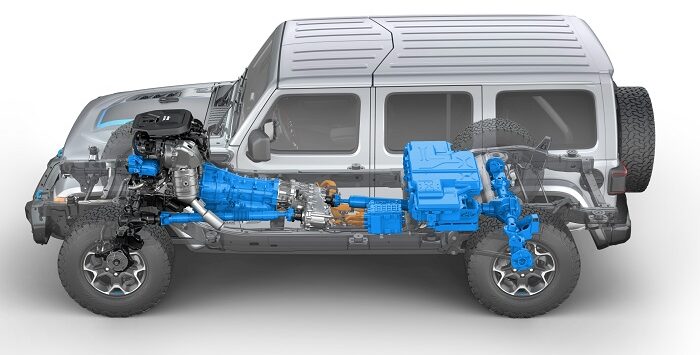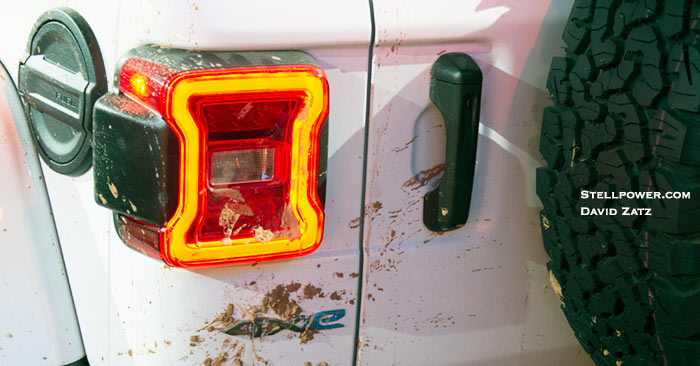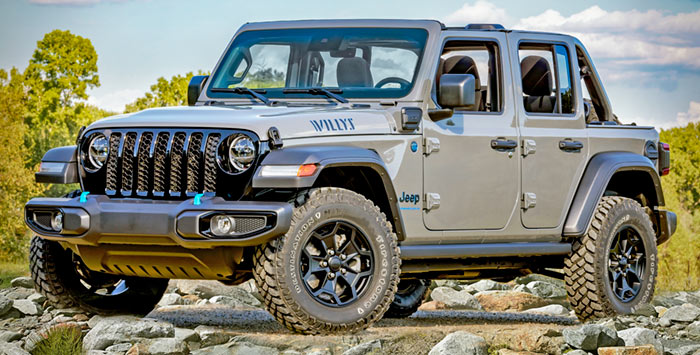The Wrangler 4xe has quickly become FCA US’ most popular plug-in hybrid. It has two advantages for buyers—it can save money compared with the base V6 gasoline engine, despite having about the same rated mileage, because it can be driven for a while on pure battery; and its has V8 acceleration which comes close to the all-out (and pricier) 392 V8.

Some time ago we reported on the experience of Allpar member valiant67, who owned two 2023 Wrangler 4xes. He was able to charge it quite cheaply and reported 29 mpg on mostly-highway use and 27 mpg in non-highway use, far better than we’d expect.
The EPA’s ratings are 20 mpg with the base V6 and 21 mpg with the hybrid setup, but this excludes the all-electric portion. (The Jeep Wrangler has never been known as one of the best cars for gas mileage.)
EPA testing found 22 miles of electric power; they rated it at 49 MPGe. As a pure hybrid, though, the combined figure was 20 mpg. The diesel remains the most fuel efficient engine, with a combined 25 mpg (and $2350/year estimated fuel costs), but its acceleration is a far cry from the quick 4xe, and diesel fuel is pricey.
The plain turbo engine also gets better mileage than the 4xe, turning in 23 mpg ($2,300/year) compared with the 4xe’s 20 mpg. However, the estimates for the 4xe are lower ($2,050/year) because they assume you will be running on just electricity now and then. (It’s important to note that the Rubicon has a gas mileage penalty of 2 mpg with the diesel.) But these are also not apples to apples comparisons. The 2023 4xe was not available across the board, but only on the four-door models. The diesel number was likewise from a four-door, but the 2.0 turbo engine quoted as from a two-door model, which is lighter. It wasn’t available on the four-doors.
![]()
The basic V6, which is the Wrangler’s standard engine, turned in 20 mpg combined in either two or four doors, with an automatic. The manual transmission drops it down to 19 mpg. The 392 engine, incidentally, is not just the only one of these to require premium fuel; it also only turns in 14 mpg, which the EPA suggests will cost owners $4,650 per year.
So now let’s do two comparisons. First, let’s say you want the best performance you can get from a Wrangler. The 392 easily beats anything else in “instant-on” performance from any speed, but the 4xe isn’t far off in 0-60 sprints. The 392 is the most expensive Jeep, and should cost at least $2,000 per year more in extra fuel costs, so economically this is not the most interesting comparison.
What might be more interesting is asking, “Does the 4xe pay off in anything but acceleration?” The answer there is, it depends. Again, the Wrangler is not the highest mpg car you can buy, but the 4xe, like the diesel, makes it a bit more like a minivan than a heavy duty pickup in gas mileage. (Incidentally, when Toyota made a Wrangler challenger, the FJ Cruiser, it did not match the Wrangler off-road, but still turned in almost identical mileage, so this is not a “Jeep doesn’t know how to get mileage” issue but an “all-out off-road credentials lower your mileage” issue.)

Let’s take the EPA at their word for the gas mileage of the V6 automatic—19 city, 24 highway, 21 combined, and $2,550 per year in fuel costs (assuming $3.54 per gallon). The 4xe version brings in 20 mpg, combined—the EPA doesn’t break that out. The cost of around 25 miles of mostly-electric driving is quoted as $2.63, compared with $4.43 on gasoline. That assumes electricity costs 14¢/kWh, so if your power costs more, the price goes up; if your power costs less, the price goes down. As an example, power in New Jersey is 16¢/kWh on average; so the cost would be around $2.90 for that first 25 miles.
Now, if you commute less than 22 miles, you can run entirely on electricity most of the time; and sometimes you can get that power for free (especially if you work at Ikea or another store with free charging). If you can charge at work at 16¢/kWh and at home for the same price, your annual cost would be around ($0.16 x 15 kWh x 200 days x 2 trips) or more like $960 for your daily commute, plus whatever shopping and vacation miles you put on. For the V6, that would be ((22 m / 20 mpg) x 3.54/gal x 200 days x 2 trips) or $1,558. That’s $598 per year just for the commute. The advantage of the 4xe also works if you’re not charging the car at all, but it’s not as big a difference.

Now comes the question of cost. Jeep has been slapping on a stunning $10,000, more or less, for the 4xe option, and it’s been selling briskly. That’s not anywhere as hefty as the Rubicon 392 package—adding 4xe to the Rubicon X tacks on “only” $10,190 vs $28,700 for the 392, which then adds a hefty annual fuel cost and most likely a sizable insurance punishment.
Does the 4xe pay off? That depends on how much you drive, and how you drive. It might quite possibly pay off quickly in a good deal of city and suburban driving, especially if you can charge it regularly. The main payoff may well be in acceleration rather than fuel economy—while fuel prices stay where they are. It also provides a quite respectable driving range, which can be helpful too.
2024 Jeep fuel economy figures have not yet been released and the 4xe estimates may change because it will be available on every model other than the base Sport and the 392.